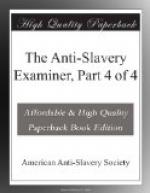But all the servants whom the apostle addressed were not “under the yoke"[52]—an instrument appropriate to cattle and to slaves. These he distinguishes from another class, who instead of a “yoke”—the badge of a slave—had “believing masters.” To have a “believing master,” then, was equivalent to freedom from “the yoke.” These servants were exhorted not to despise their masters. What need of such an exhortation, if their masters had been slaveholders, holding them as property, wielding them as mere instruments, disposing of them as “articles of merchandise.” But this was not consistent with believing. Faith, “breaking every yoke,” united master and servants in the bonds of brotherhood. Brethren they were, joined in a relation which, excluding the yoke,[53] placed them side by side on the ground of equality, where, each in his appropriate sphere, they might exert themselves freely and usefully, to the mutual benefit of each other. Here, servants might need to be cautioned against getting above their appropriate business, putting on airs, despising their masters, and thus declining or neglecting their service. [54] Instead of this, they should be, as emancipated slaves often have been, [55] models of enterprise, fidelity, activity, and usefulness—especially as their masters were “worthy of their confidence and love,” their helpers in this well-doing.
[Footnote 52: See Lev. xxvi. 13; Isa lviii. 6, 9.]
[Footnote 53: Supra p. 44.]
[Footnote 54: See Mat. vi. 24.]
[Footnote 55: Those, for instance, set free by that “believing master” James G. Birney.]
Such, then, is the relation between those who, in the view of Professor Stuart, were Christian masters and Christian slaves [56]—the relation of “brethren,” which, excluding “the yoke,” and of course conferring freedom, placed them side by side on the common ground of mutual service, both retaining, for convenience sake, the one while giving and the other while receiving employment, the correlative name, as is usual in such cases, under which they had been known. Such was the instruction which Timothy was required, as a Christian minister, to give. Was it friendly to slaveholding?
[Footnote 56: Letter to Dr. Fisk, supra, p. 7.]
And on what ground, according to the Princeton professor, did these masters and these servants stand in their relation to each other? On that of a “perfect religious equality."[57] In all the relations, duties, and privileges—in all the objects, interests, and prospects, which belong to the province of Christianity, servants were as free as their master. The powers of the one, were allowed as wide a range and as free an exercise, with as warm encouragements, as active aids, and as high results, as the other. Here, the relation of a servant to his master imposed no restrictions, involved no embarrassments, occasioned no injury. All this, clearly and certainly, is




